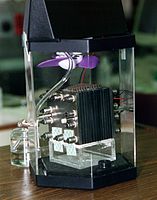
Photo from wikipedia
During high current density operation, water production in the polymer electrolyte membrane fuel cell (PEMFC) cathode catalyst layer can negatively affect performance by lowering mass transport of oxygen into the… Click to show full abstract
During high current density operation, water production in the polymer electrolyte membrane fuel cell (PEMFC) cathode catalyst layer can negatively affect performance by lowering mass transport of oxygen into the cathode. In this paper, a novel heat treatment process for controlling the ionic polymer/gas interface property of the fuel cell catalyst layer is investigated and then incorporated into the membrane electrode assembly (MEA) fabrication process. XPS characterization of the catalyst layer's ionomer-gas interface at its outer surface and its sublayers’ surfaces obtained by scraping off successive layers of the catalyst layers confirms that a hydrophobic ionomer interface can be achieved across the catalyst layer using a specific heat treatment condition. Based on the results of the catalyst layer study, the MEA fabrication process is modified to identify heat treatment configuration and conditions that will create an optimal hydrophobic ionomer-gas interface inside the cathode catalyst layer. Finally, fuel cell tests conducted on the conventional and new MEAs under different operating temperatures show the performance of the fuel cells with the treated MEAs was > 130% higher than that with the conventional MEA at 25 °C and 70 °C with humidified air and > 45% higher at 70 °C with dry air. The durability of the hydrophobic treatment on the cathode catalyst layer ionomer is also confirmed by the accelerated stress test. PEMFC Catalyst Layer with Hydrophobic Ionomer/Gas Interface
Journal Title: Journal of Applied Electrochemistry
Year Published: 2020
Link to full text (if available)
Share on Social Media: Sign Up to like & get
recommendations!